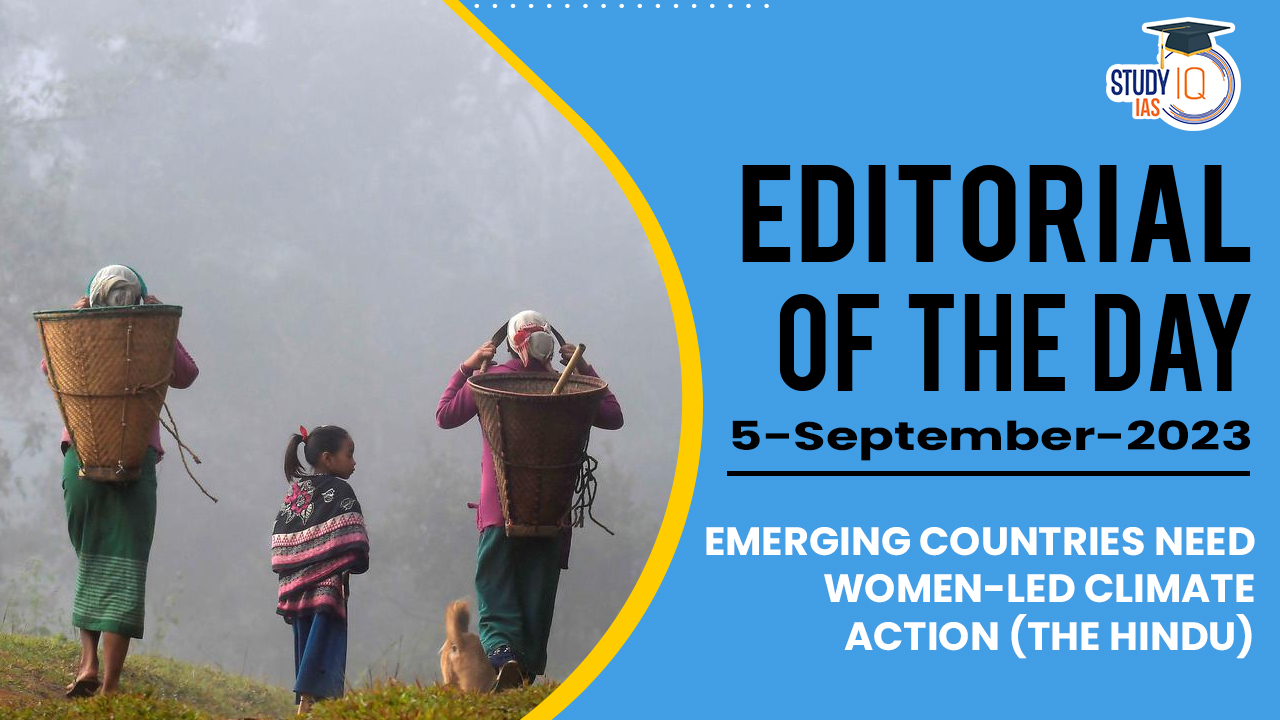Table of Contents
Context: The article is discussing the interconnectedness of gender equality and environmental sustainability goals, particularly in the context of the Sustainable Development Goals (SDGs). Specifically, it points out that climate change is a significant global challenge with far-reaching consequences for humanity. These consequences, however, are not evenly distributed and can vary based on factors such as geographical location, socioeconomic status, and gender. Furthermore, the article highlights that women, in general, are considered to be highly vulnerable to the impacts of climate change, and they are disproportionately affected compared to men. In essence, the article is emphasizing the importance of considering gender perspectives in climate change and environmental policies and strategies to ensure that the most vulnerable populations, including women, are adequately protected and included in efforts to address climate change and achieve sustainable development goals.
Decoding the Editorial
- The article highlights the idea that gender equality and environmental sustainability are not separate issues but are mutually reinforcing and can create a positive feedback loop to accelerate progress towards achieving the SDGs.
- It also predicts that a substantial portion of working hours worldwide will be lost due to high temperatures by 2030, resulting in a significant productivity loss equivalent to 80 million full-time jobs. This loss of productivity can have serious social and economic implications.
- Furthermore, the article highlights that women, in general, are considered to be highly vulnerable to the impacts of climate change and this vulnerability is attributed to factors such as their reliance on natural resources and engagement in labour-intensive work in certain regions of the world.
Status in Lower Income Countries:
- Vulnerability of Women: Women, globally, face significant risks to their health, safety, and overall quality of life due to the effects of climate change. However, women in developing and low-income regions are even more vulnerable.
- Dependence on Natural Resources: Women in these regions are often dependent on natural resources and engage in labor-intensive work as a means of livelihood. This dependence on nature and labor-intensive jobs makes them particularly susceptible to the adverse impacts of climate change.
- Poverty and Gender Inequality: Women are more likely to live in poverty compared to men. Poverty is just one of several social, economic, and cultural factors that increase their vulnerability to climate change. Gender inequality plays a significant role in exacerbating the challenges women face in the context of climate change.
- Unpaid Domestic Work: Women from low-income households are often responsible for unpaid domestic work, including ensuring access to clean water, cooking fuel, and nutritious food for their families. Climate change can make it even more difficult and time-consuming for them to obtain these basic necessities.
- Health and Safety Risks: Climate change can increase health and safety risks for women, particularly in rural areas. They may have to travel long distances daily to collect water and fuel, exposing them to various hazards.
- Occupations and Land Ownership: Women in low-income countries, particularly in South Asia and sub-Saharan Africa, often engage in climate-vulnerable occupations such as farming and other labor-intensive work. Despite their crucial role in food production, they tend to own very little of the land they work on and are often underpaid and overworked.
- Potential for Climate Refugees: The study by McAllister (2023) highlights the alarming possibility that climate change could lead to a significant number of climate refugees, with estimates suggesting as many as 1.2 billion by 2050. This implies that the adverse impacts of climate change, including extreme weather events and resource scarcity, could displace a large number of people, and women are likely to be among the most affected by such displacement.
Gender-specific issues related to climate change:
- Disproportionate Displacement: According to a UN study, a significant majority (80%) of people displaced by climate-related disasters are women and girls.
- Vulnerabilities During and After Disasters: Women, especially those from vulnerable communities, face specific challenges during and after natural disasters. When displaced, women become more susceptible to prejudice and exploitation.
- Example: During the earthquake in Nepal in 2015, women were found to be at higher risk of trafficking and exploitation.
- Social Isolation: Separation from social networks is a common consequence of displacement, which can further exacerbate the vulnerability of women. They may lack the support and protection that social networks can provide.
- Gender-Based Violence: Women in such situations also face a higher risk of gender-based violence, which can further compound their hardships.
- Limited Access to Services: Displaced women often have reduced access to essential services, including employment, education, and healthcare. This includes services such as sexual and reproductive health care and psychosocial support.
- Impact on Agricultural Workforce: Women play a significant role in the agricultural workforce in emerging countries. Climate change negatively affects agricultural productivity through factors like heat stress, changing precipitation patterns, and extreme weather events, particularly in South Asia and Africa. These impacts disproportionately affect women who are already facing challenges in accessing resources, expertise, and technology.
- Water Scarcity and Violence: Flooding caused by climate change can exacerbate water scarcity issues and increase the risk of violence against and exploitation of women in affected regions.
Way Forward
Invest in women’s education, training:
According to estimates, 130 million people could be pushed into poverty by 2050 due to climate change risks, natural disasters, and food inflation, impacting women’s inequality. When it comes to adjusting to a changing climate, women have a lot to offer.
- Investments in women’s education, training, and access to resources are essential if we are to be resilient to the impact of climate change.
- Reduce the negative impacts of climate change on people’s living standards by teaching them how to practise sustainable agriculture, water management, and energy generation.
- For example, in India, the Self-Employed Women’s Association (SEWA) teaches women farmers how to respond to shifting climate patterns to support themselves better financially.
- Therefore, it is essential to support groups that educate the public, train people to adapt to climate change and invest in women’s education and training in environmentally-friendly farming methods.
- Women’s participation in climate policy decision-making at all levels is crucial for effective climate change mitigation and adaptation strategies as well as getting decent employment.
- As women face greater risks in climate change, gender parity in decision-making bodies is essential.
- One such programme in South Asia is the Gender and Climate Change Development Programme, which aims to increase women’s influence in policy making by providing them with a stronger voice.
- Globally, similar efforts are required for efficient climate change adaptation and mitigation.


 UPSC CDS 1 Final Result 2025 Declared: D...
UPSC CDS 1 Final Result 2025 Declared: D...
 Ramsar Sites in India 2025 List: Names, ...
Ramsar Sites in India 2025 List: Names, ...
 SEBI’s SWAGAT-FI Framework for Low-Ris...
SEBI’s SWAGAT-FI Framework for Low-Ris...

























